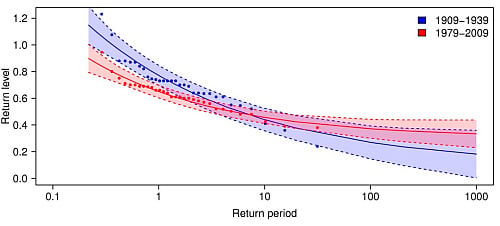Trends in Water Level and Flooding in Dhaka, Bangladesh and Their Impact on Mortality
Abstract
:1. Introduction
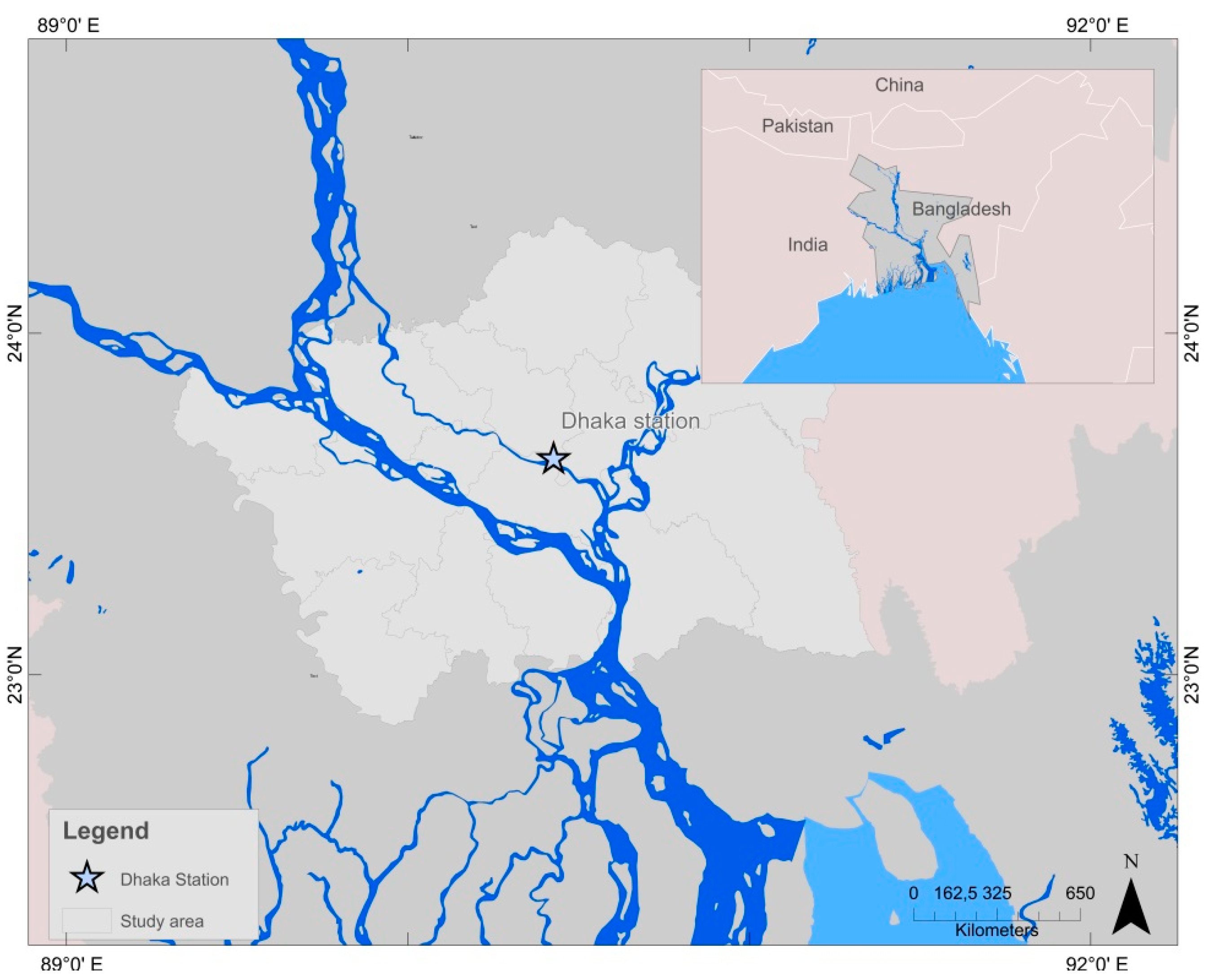
2. Data and Methodology
2.1. Data
2.1.1. Hydrometeorological Data
2.1.2. Mortality Data
| Statistic | Water Level (m) | Temperature (°C) | Mortality a (Count) | |||
|---|---|---|---|---|---|---|
| 1909–2009 | 2003–2007 | 2003–2007 | 2003–2007 | |||
| Low Tide | High Tide | Low Tide | High Tide | |||
| Min | 0.24 | 0.55 | 0.60 | 0.98 | 11.9 | 1 |
| Mean | 2.77 | 3.04 | 2.71 | 3.06 | 26.0 | 3.7 |
| Max | 7.55 | 7.58 | 6.65 | 6.68 | 32.6 | 12 |
| Stdev | 1.66 | 1.48 | 1.52 | 1.35 | 4.1 | 2.0 |
2.2. Methodology
2.2.1. Extreme Value Theory
2.2.2. Distributed Lag Non-Linear Models
3. Results
3.1. Assessment of Historic Changes in Water Levels in Dhaka
3.1.1. Changes in Frequency and Magnitude
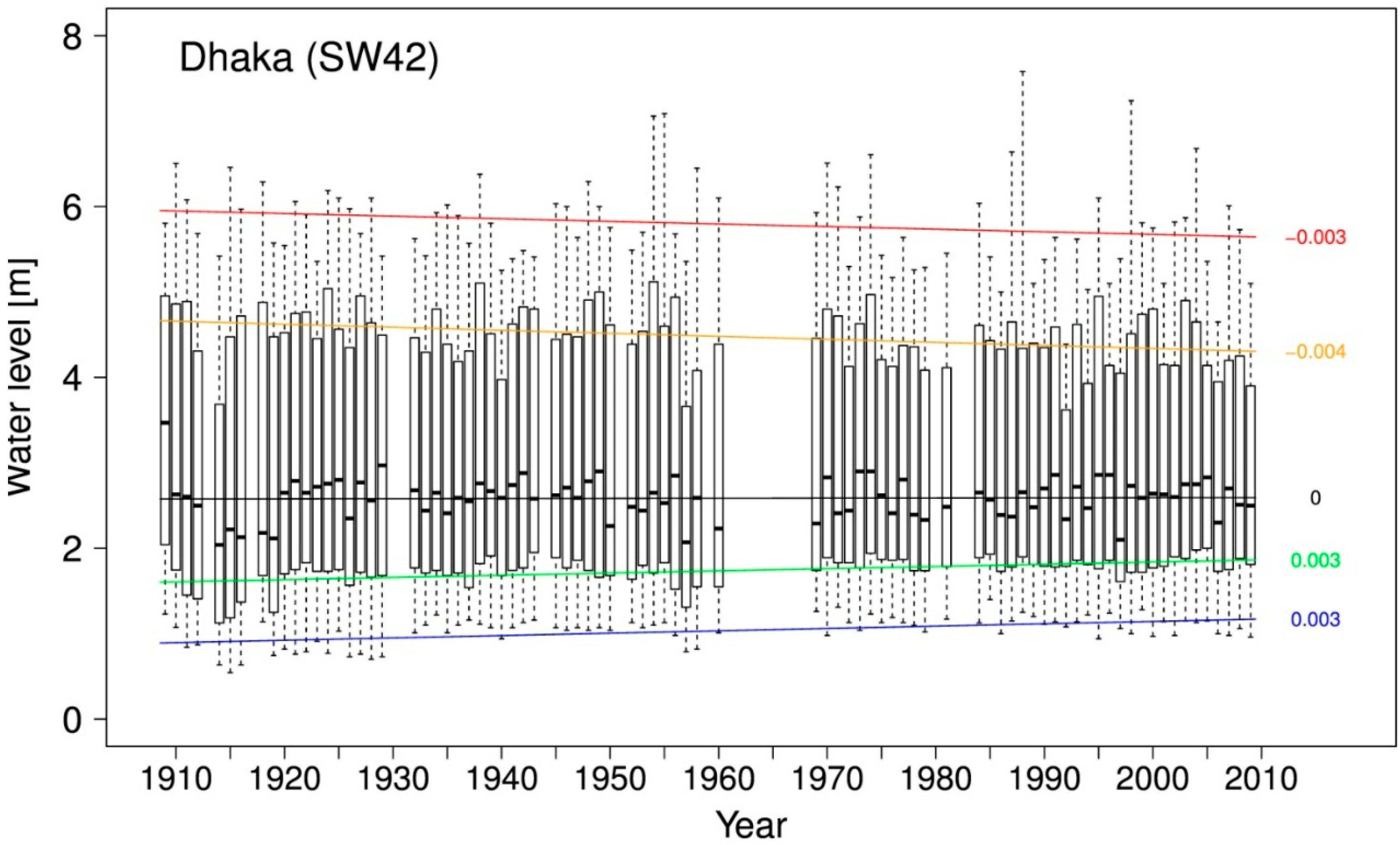
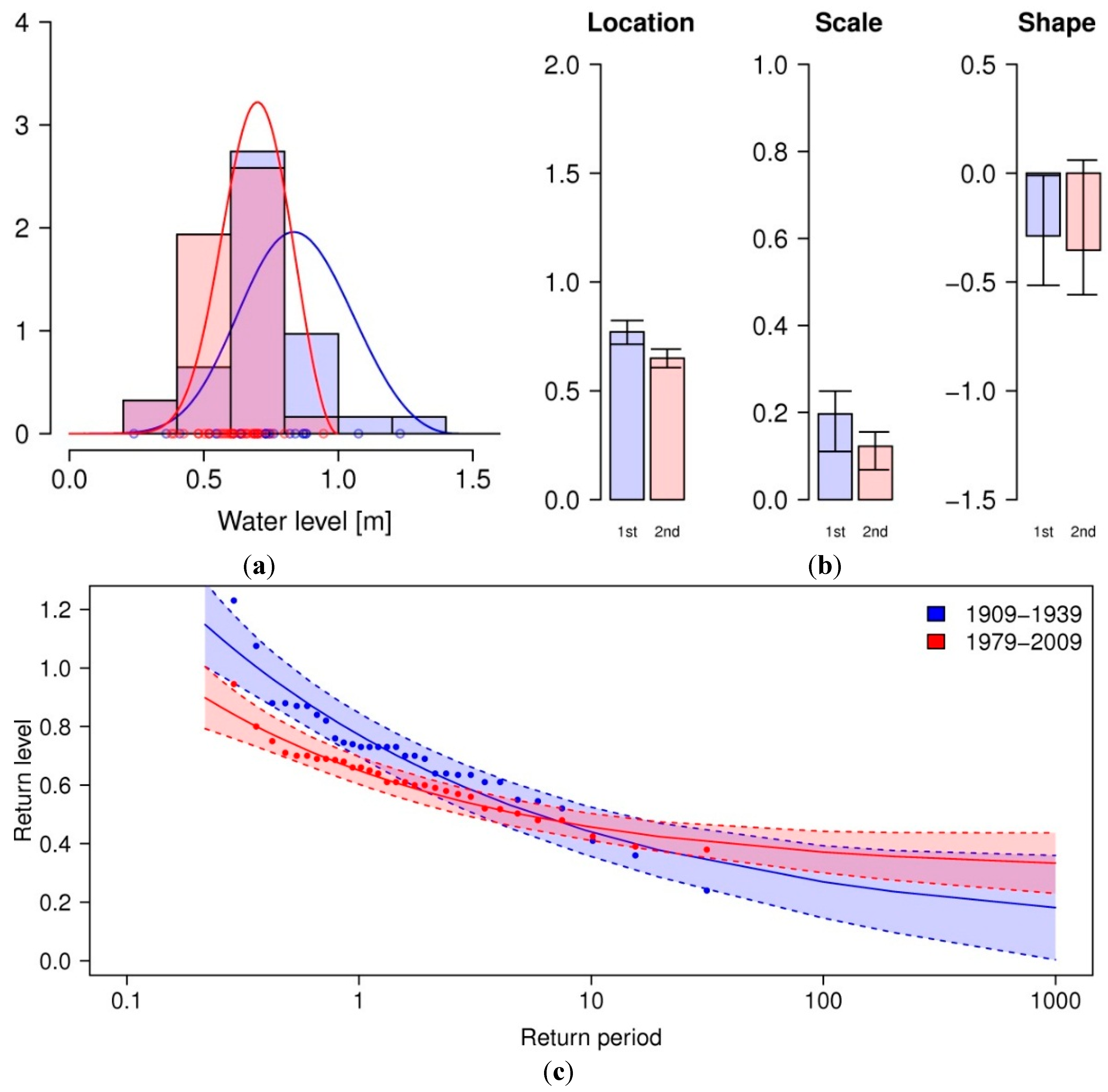
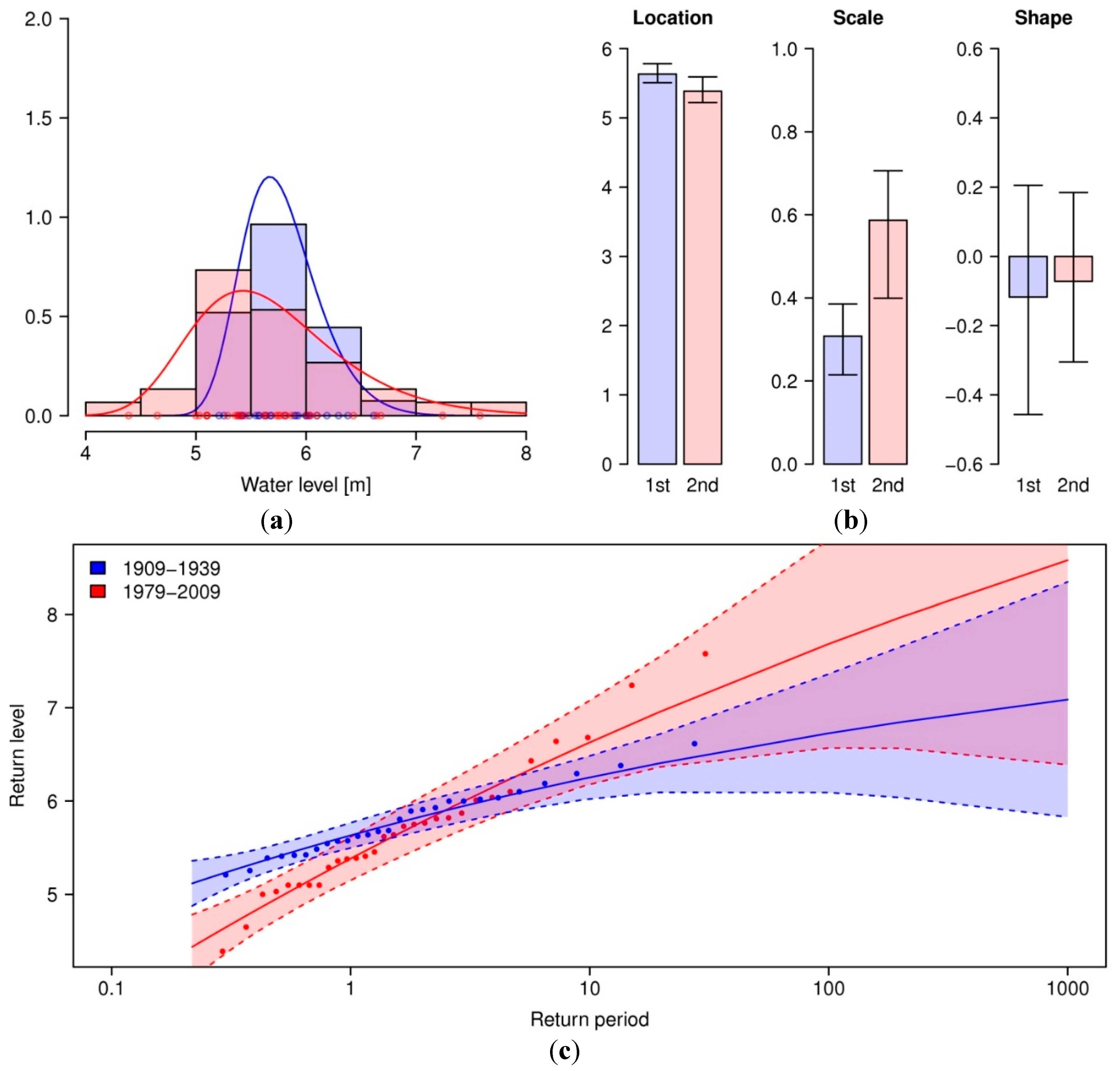
3.1.2. Changes in Flood Duration
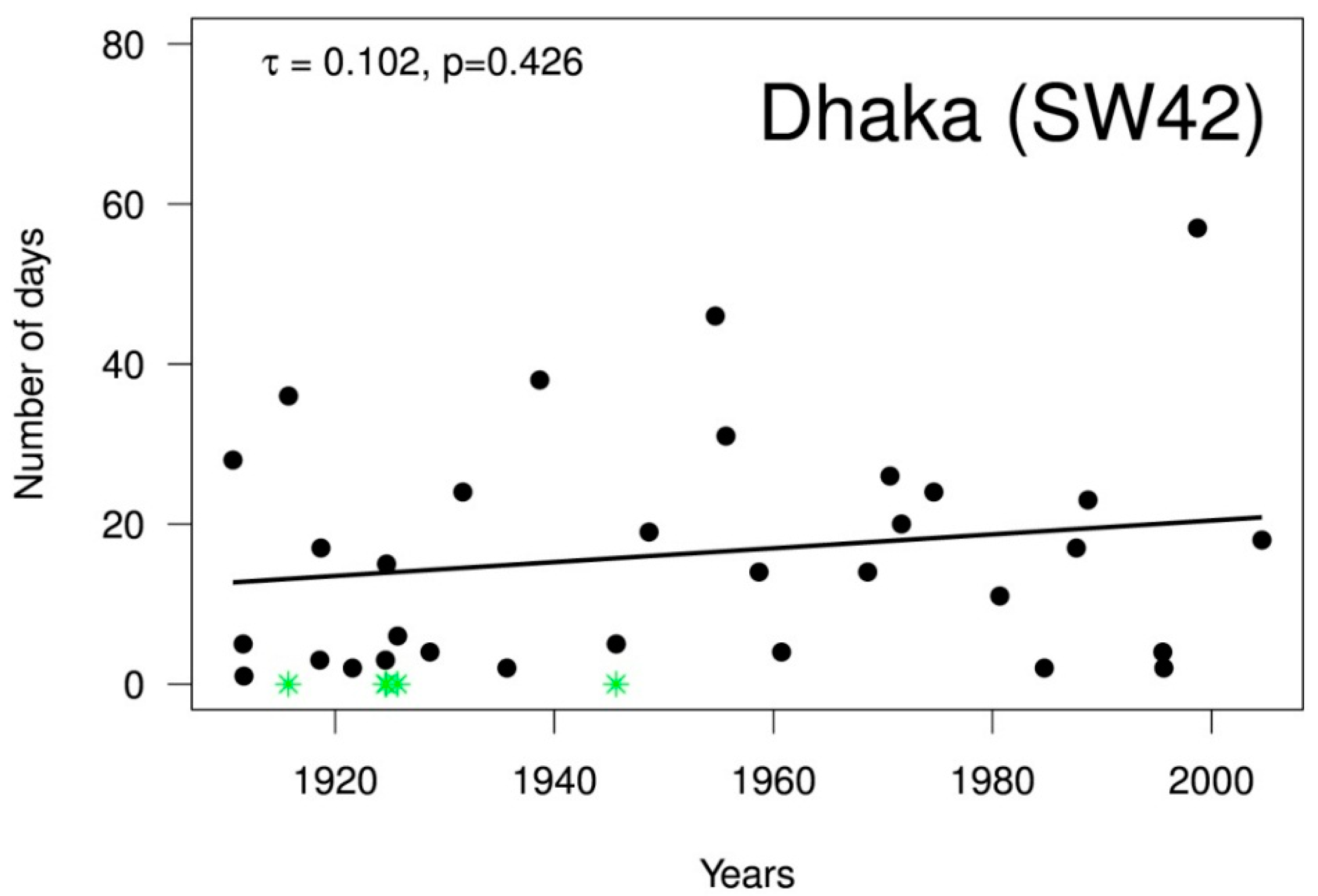
3.2. Mortality and Extreme Events
3.2.1. Flood Event of 2004
3.2.2. Flood Event of 2007

3.3. Relationship between Water Level and Mortality in Greater Dhaka

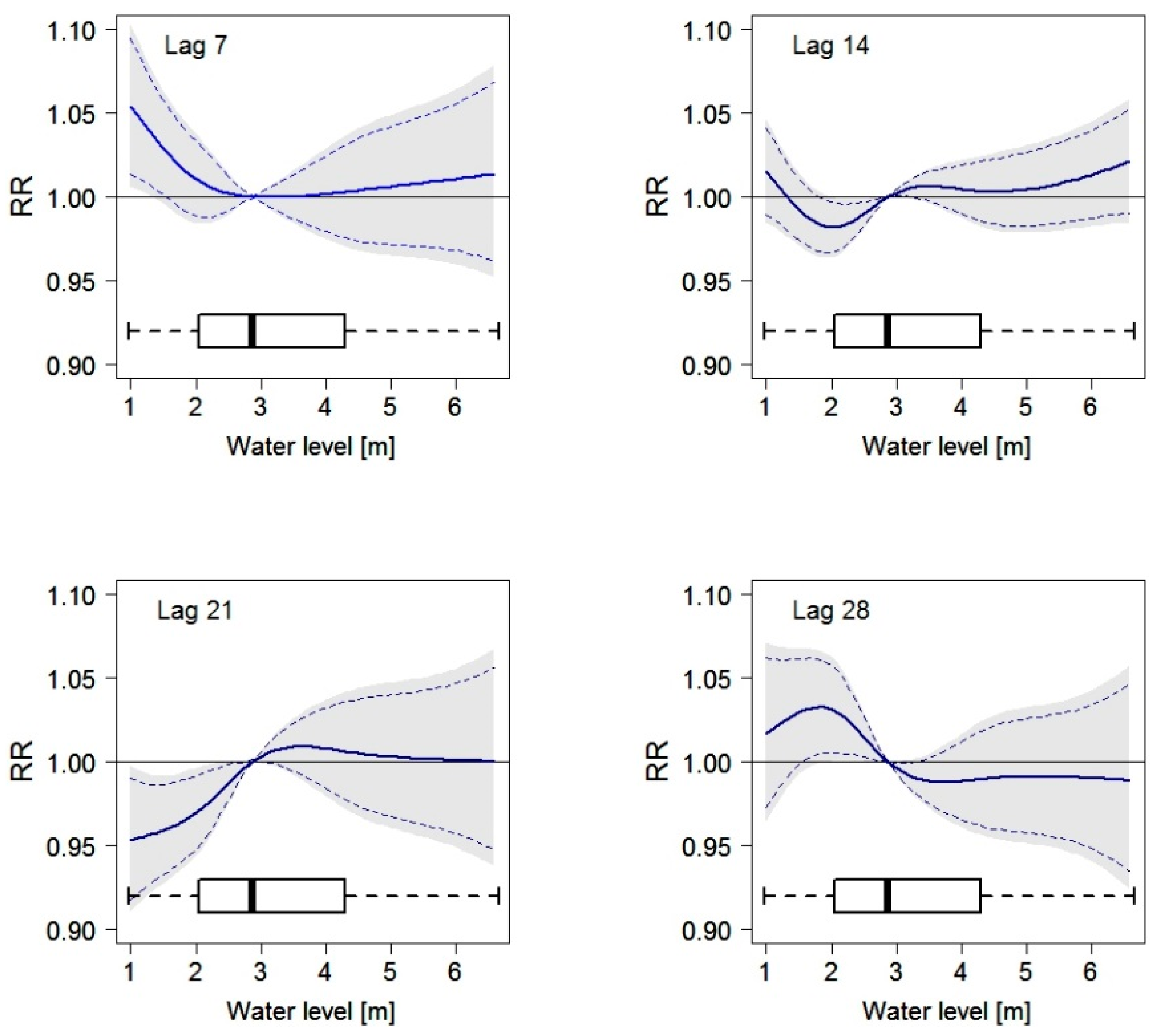

4. Discussion
5. Conclusions
Acknowledgments
Author Contributions
Conflicts of Interest
References and Notes
- Arnell, N.W. Climate change and global water resources. Glob. Environ. Chang. 1999, 9, S31–S49. [Google Scholar] [CrossRef]
- IPCC. Climate Change 2013: The Physical Science Basis. Contribution of Working Group I to the Fifth Assessment Report of the Intergovernmental Panel on Climate Change; Cambridge University Press: Cambridge, UK; New York, NY, USA, 2013; p. 1535. [Google Scholar]
- IPCC. Climate Change 2014: Impacts, Adaptation, and Vulnerability. Part A: Global and Sectoral Aspects. Contribution of Working Group II to the Fifth Assessment Report of the Intergovernmental Panel on Climate Change; Cambridge University Press: Cambridge, UK; New York, NY, USA, 2014; p. 1132. [Google Scholar]
- Milly, P.C.D.; Wetherald, R.T.; Dunne, K.A.; Delworth, T.L. Increasing risk of great floods in a changing climate. Nature 2002, 415, 514–517. [Google Scholar] [CrossRef] [PubMed]
- Few, R. Flooding, vulnerability and coping strategies: Local responses to a global threat. Prog. Dev. Stud. 2003, 3, 43–58. [Google Scholar] [CrossRef]
- Organization for Economic Cooperation and Development (OECD). Environment Working Paper. Screening Study: Ranking Port Cities with High Exposure and Vulnerability to Climate Extremes. Interim Analysis: Exposure Estimates; OECD: Paris, France, 2007. [Google Scholar]
- Risk and Poverty in a Changing Climate. Available online: http://www.preventionweb.net/files/9414_GARsummary.pdf (accessed on 21 January 2015).
- Revealing Risk, Redefining Development. Available online: http://www.preventionweb.net/english/hyogo/gar/2011/en/home/index.html (accessed on 21 January 2015).
- Patt, A.G.; Tadross, M.; Nussbaumer, P.; Asante, K.; Metzger, M.; Rafael, J.; Goujon, A.; Brundrit, G. Estimating least-developed countries’ vulnerability to climate-related extreme events over the next 50 years. Proc. Natl. Acad. Sci. USA 2010, 107, 1333–1337. [Google Scholar] [CrossRef] [PubMed]
- United Nations. World Urbanization Prospects: The 2005 Revision; United Nations Population Division, Department of Economic and Social Affairs, CD-ROM Edition-Data in Digital Form (POP/DB/WUP/Rev.2005), United Nations: New York, NY, USA, 2006. [Google Scholar]
- Alam, M.; Rabbani, M.D.G. Vulnerabilities and responses to climate change for Dhaka. Environ. Urban. 2007, 19, 81–97. [Google Scholar] [CrossRef]
- Reazuddin and Team. In Report: Banning Polyethylene Shopping Bags: A Step Forward to Promoting Environmentally Sustainable Development in Bangladesh; Bangladesh Centre for Advanced Studies: Dhaka, Bangladesh, 2006.
- Brouwer, R.; Akter, S.; Brander, L.; Haque, E. Socioeconomic vulnerability and adaptation to environmental risk: A case study of climate change and flooding in Bangladesh. Risk Anal. 2007, 27, 313–326. [Google Scholar] [CrossRef] [PubMed]
- Alderman, K.; Turner, L.R.; Tong, S. Floods and human health: A systematic review. Environ. Int. 2012, 47, 37–47. [Google Scholar] [CrossRef] [PubMed] [Green Version]
- Lowe, D.; Ebi, K.L.; Forsberg, B. Factors increasing vulnerability to health effects before, during and after floods. Int. J. Environ. Res. Public Health 2013, 10, 7015–7067. [Google Scholar] [CrossRef] [PubMed]
- Sirajul Islam, M.; Brooks, A.; Kabir, M.S.; Jahid, I.K.; Shafiqul Islam, M.; Goswami, D.; Nair, G.B.; Larson, C.; Yukiko, W.; Luby, S. Faecal contamination of drinking water sources of Dhaka city during the 2004 flood in Bangladesh and use of disinfectants for water treatment. J. Appl. Microbiol. 2007, 103, 80–87. [Google Scholar]
- Islam, A.S.; Haque, A.; Bala, S. Hydrologic characteristics of floods in Ganges–Brahmaputra–Meghna (GBM) delta. Nat. Hazards 2010, 54, 797–811. [Google Scholar] [CrossRef]
- Mirza, M.M. Climate change, flooding in South Asia and implications. Reg. Environ. Chang. 2011, 11, 95–107. [Google Scholar] [CrossRef]
- Khalequzzaman, M.D. Recent floods in Bangladesh: Possible causes and solutions. Nat. Hazards 1994, 9, 65–80. [Google Scholar] [CrossRef]
- Dey, N.; Alam, M.; Sajjan, A.; Bhuiyan, M.; Ghose, L.; Ibaraki, Y.; Karim, F. Assessing environmental and health impact of drought in the Northwest Bangladesh. J. Environ. Sci. Nat. Resour. 2011, 42, 89–97. [Google Scholar]
- Jonkman, S.N. Global perspectives on loss of human life caused by floods. Nat. Hazards 2005, 34, 151–175. [Google Scholar] [CrossRef]
- Hashimoto, M.; Suetsugi, T.; Sunada, K.; ICRE. Study on the flood simulation techniques for estimation of health risk in Dhaka city, Bangladesh. In American Geophysical Union, Fall Meeting; American Geophysical Union: San Francisco, CA, USA, 2011; Abstract #H23H-1370. [Google Scholar]
- Ahern, M.; Kovats, R.S.; Wilkinson, P.; Few, R.; Matthies, F. Global health impacts of floods: Epidemiologic evidence. Epidemiol. Rev. 2005, 27, 36–46. [Google Scholar] [CrossRef] [PubMed]
- Du, W.; FitzGerald, G.J.; Clark, M.; Hou, X.Y. Health impacts of floods. Prehospital Disaster Med. 2010, 25, 265–272. [Google Scholar] [PubMed]
- Patz, J.A.; Campbell-Lendrum, D.; Holloway, T.; Foley, J.A. Impact of regional climate change on human health. Nature 2005, 438, 310–317. [Google Scholar] [CrossRef] [PubMed]
- Bangladesh Bureau of Statistics. Report on the Sample Vital Registration System 2007; Bangladesh Bureau of Statistics: Dhaka, Bangladesh, 2008. [Google Scholar]
- Burkart, K.; Khan, M.; Kramer, A.; Breitner, S.; Schneider, A.; Endlicher, W. Seasonal variations of all-cause and cause-specific mortality by age, gender, and socioeconomic condition in urban and rural areas of Bangladesh. Int. J. Equity Health 2011, 10. [Google Scholar] [CrossRef]
- Burkart, K.; Schneider, A.; Breitner, S.; Khan, M.H.; Krämer, A.; Endlicher, W. The effect of atmospheric thermal conditions and urban thermal pollution on all-cause and cardiovascular mortality in Bangladesh. Environ. Pollut. 2011, 159, 2035–2043. [Google Scholar] [CrossRef] [PubMed]
- Coles, S. An Introduction to Statistical Modeling of Extreme Values; Springer: London, UK, 2001. [Google Scholar]
- ismev: An Introduction to Statistical Modeling of Extreme Values. R Package Version 1.35. Available online: http://CRAN.R-project.org/package=ismev (accessed on 19 January 2015).
- Gasparrini, A. Distributed lag linear and non-linear models in R: The package dlnm. J. Stat. Softw. 2011, 43, 1–20. [Google Scholar] [PubMed]
- Gasparrini, A.; Armstrong, B.; Kenward, M. Distributed lag nonlinear models. Stat. Med. 2010, 29, 2224–2234. [Google Scholar] [CrossRef] [PubMed]
- Burkart, K.; Breitner, S.; Schneider, A.; Khan, M.M.; Krämer, A.; Endlicher, W. An analysis of heat effects in different subpopulations of Bangladesh. Int. J. Biometeorol. 2014, 58, 227–237. [Google Scholar] [CrossRef] [PubMed]
- Disaster Management Bureau: Ministry of Food and Disaster Management For Government of the Peoples Republic of Bangladesh with the assistance of comprehensive Disaster Management Programme (CDMP). Available online: http://www.ddm.gov.bd/ (accessed on 21 Januray 2015).
- Mirza, M.M.Q.; Warrick, R.A.; Ericksen, N.J.; Kenny, G.J. Are floods getting worse in the Ganges, Brahmaputra and Meghna basins? Glob. Environ. Chang. Part B Environ. Hazards 2001, 3, 37–48. [Google Scholar] [CrossRef]
- Aßheuer, T. Klimawandel und Resilienz in Bangladesch: Die Bewältigung von Überschwemmungen in den Slums von Dhaka; Franz Steiner Verlag: Stuttgart, Germany, 2014. [Google Scholar]
- Milojevic, A.; Armstrong, B.; Hashizume, M.; McAllister, K.; Faruque, A.; Yunus, M.; Kim Streatfield, P.; Moji, K.; Wilkinson, P. Health effects of flooding in rural Bangladesh. Epidemiology 2012, 23, 107–115. [Google Scholar] [CrossRef] [PubMed]
- Aßheuer, T.; Thiele-Eich, I.; Braun, B. Coping with the impacts of severe flood events in Dhaka’s slums—The role of social capital. Erdkunde 2013, 67, 21–35. [Google Scholar] [CrossRef]
- Ashley, S.T.; Ashley, W.S. Flood fatalities in the United States. J. Appl. Meteorol. Climatol. 2008, 47, 805–818. [Google Scholar] [CrossRef]
- Hashizume, M.; Armstrong, B.; Hajat, S.; Wagatsuma, Y.; Faruque, A.S.; Hayashi, T.; Sack, D.A. Association between climate variability and hospital visits for non-cholera diarrhoea in Bangladesh: Effects and vulnerable groups. Int. J. Epidemiol. 2007, 36, 1030–1037. [Google Scholar] [CrossRef] [PubMed]
- Zhang, Y.; Bi, P.; Hiller, J.E.; Sun, Y.; Ryan, P. Climate variations and bacillary dysentery in northern and southern cities of China. J. Infect. 2007, 55, 194–200. [Google Scholar] [CrossRef] [PubMed]
- Akanda, A.S.; Jutla, A.S.; Islam, S. Dual peak cholera transmission in Bengal Delta: A hydroclimatological explanation. Geophys. Res. Lett. 2009, 36. [Google Scholar] [CrossRef]
- Hashizume, M.; Wagatsuma, Y.; Faruque, A.; Hayashi, T.; Armstrong, B. Climatic components of seasonal variation in Cholera incidence. Epidemiology 2009, 20, 706–710. [Google Scholar] [CrossRef]
- Morris, B.; Seddique, A.A.; Ahmed, K.M. Response of the Dupi Tila aquifer to intensive pumping in Dhaka, Bangladesh. Hydrogeol. J. 2003, 11, 496–503. [Google Scholar] [CrossRef] [Green Version]
- Milojevic, A.; Armstrong, B.; Kovats, S.; Butler, B.; Hayes, E.; Leonardi, G.; Murray, V.; Wilkinson, P. Long-term effects of flooding on mortality in England and Wales, 1994–2005: Controlled interrupted time-series analysis. Environ. Health 2011, 10. [Google Scholar] [CrossRef]
- Hess, J.; McDowell, J.; Luber, G. Integrating climate change adaptation into public health practice: Using adaptive management to increase adaptive capacity and build resilience. Environ. Health Perspect. 2012, 120, 171–179. [Google Scholar] [CrossRef] [PubMed]
- Faisal, I.M.; Kabir, M.R.; Nishat, A. The disastrous flood of 1998 and long term mitigation strategies for Dhaka City. Nat. Hazards 2003, 28, 85–99. [Google Scholar] [CrossRef]
- Habiba, U.; Shaw, R.; Takeuchi, Y. Farmers’ adaptive practices for drought risk reduction in the northwest region of Bangladesh. Nat. Hazards 2014, 72, 337–359. [Google Scholar] [CrossRef]
© 2015 by the authors; licensee MDPI, Basel, Switzerland. This article is an open access article distributed under the terms and conditions of the Creative Commons Attribution license (http://creativecommons.org/licenses/by/4.0/).
Share and Cite
Thiele-Eich, I.; Burkart, K.; Simmer, C. Trends in Water Level and Flooding in Dhaka, Bangladesh and Their Impact on Mortality. Int. J. Environ. Res. Public Health 2015, 12, 1196-1215. https://doi.org/10.3390/ijerph120201196
Thiele-Eich I, Burkart K, Simmer C. Trends in Water Level and Flooding in Dhaka, Bangladesh and Their Impact on Mortality. International Journal of Environmental Research and Public Health. 2015; 12(2):1196-1215. https://doi.org/10.3390/ijerph120201196
Chicago/Turabian StyleThiele-Eich, Insa, Katrin Burkart, and Clemens Simmer. 2015. "Trends in Water Level and Flooding in Dhaka, Bangladesh and Their Impact on Mortality" International Journal of Environmental Research and Public Health 12, no. 2: 1196-1215. https://doi.org/10.3390/ijerph120201196




